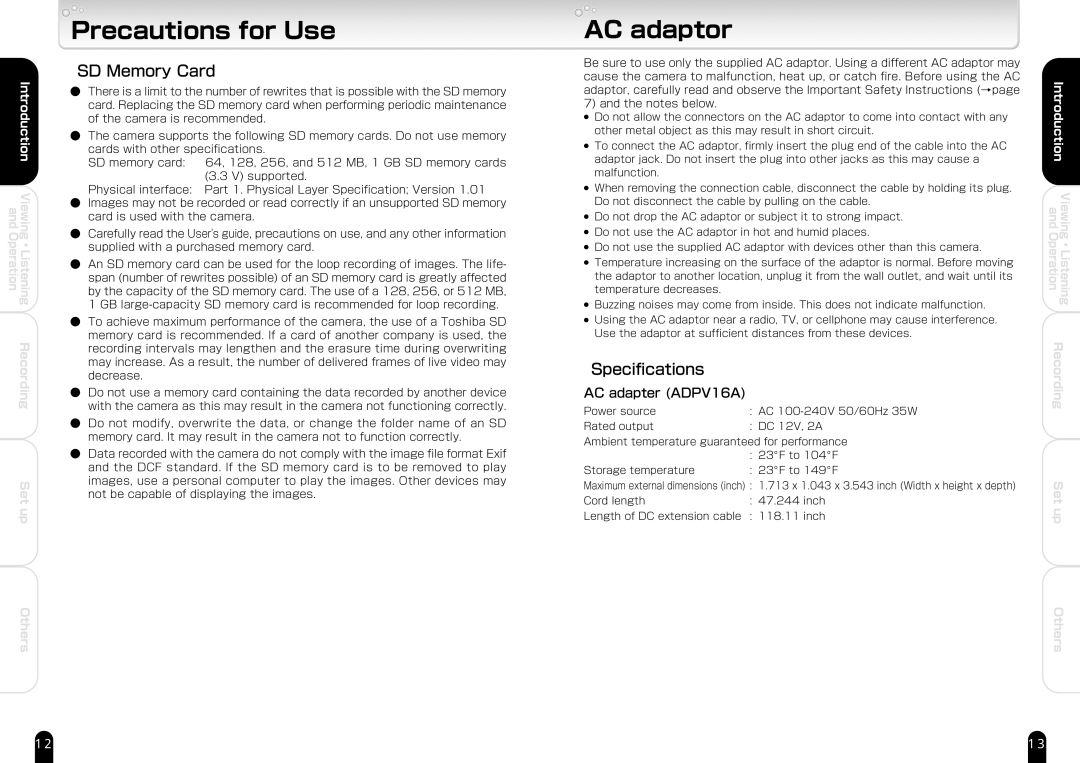
and Operation
Introduction
Viewing ・ Listening
Recording
Set up
Others
Precautions for Use
SD Memory Card
●There is a limit to the number of rewrites that is possible with the SD memory card. Replacing the SD memory card when performing periodic maintenance of the camera is recommended.
●The camera supports the following SD memory cards. Do not use memory
cards with other specifications.
SD memory card: 64, 128, 256, and 512 MB, 1 GB SD memory cards (3.3 V) supported.
Physical interface: Part 1. Physical Layer Specification; Version 1.01
●Images may not be recorded or read correctly if an unsupported SD memory card is used with the camera.
●Carefully read the User's guide, precautions on use, and any other information supplied with a purchased memory card.
●An SD memory card can be used for the loop recording of images. The life- span (number of rewrites possible) of an SD memory card is greatly affected by the capacity of the SD memory card. The use of a 128, 256, or 512 MB, 1 GB
●To achieve maximum performance of the camera, the use of a Toshiba SD memory card is recommended. If a card of another company is used, the recording intervals may lengthen and the erasure time during overwriting may increase. As a result, the number of delivered frames of live video may decrease.
●Do not use a memory card containing the data recorded by another device with the camera as this may result in the camera not functioning correctly.
●Do not modify, overwrite the data, or change the folder name of an SD memory card. It may result in the camera not to function correctly.
●Data recorded with the camera do not comply with the image file format Exif and the DCF standard. If the SD memory card is to be removed to play images, use a personal computer to play the images. Other devices may not be capable of displaying the images.
AC adaptor
Be sure to use only the supplied AC adaptor. Using a different AC adaptor may cause the camera to malfunction, heat up, or catch fire. Before using the AC adaptor, carefully read and observe the Important Safety Instructions (→page 7) and the notes below.
●Do not allow the connectors on the AC adaptor to come into contact with any other metal object as this may result in short circuit.
●To connect the AC adaptor, firmly insert the plug end of the cable into the AC adaptor jack. Do not insert the plug into other jacks as this may cause a malfunction.
●When removing the connection cable, disconnect the cable by holding its plug. Do not disconnect the cable by pulling on the cable.
●Do not drop the AC adaptor or subject it to strong impact.
●Do not use the AC adaptor in hot and humid places.
●Do not use the supplied AC adaptor with devices other than this camera.
●Temperature increasing on the surface of the adaptor is normal. Before moving the adaptor to another location, unplug it from the wall outlet, and wait until its temperature decreases.
●Buzzing noises may come from inside. This does not indicate malfunction.
●Using the AC adaptor near a radio, TV, or cellphone may cause interference. Use the adaptor at sufficient distances from these devices.
Specifications
AC adapter (ADPV16A)
Power source | : AC | |
Rated output | : DC 12V, 2A | |
Ambient temperature guaranteed for performance | ||
| : | 23。F to 104。F |
Storage temperature | : | 23。F to 149。F |
Maximum external dimensions (inch) : | 1.713 x 1.043 x 3.543 inch (Width x height x depth) | |
Cord length | : | 47.244 inch |
Length of DC extension cable | : | 118.11 inch |
Introduction | |
and | Viewing |
Operation | Listening |
| ・ |
Recording | |
Set up
Others
12 | 13 |
